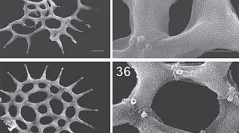

 Cryptogamie, Algologie
37 (4) - Pages 273-295
Cryptogamie, Algologie
37 (4) - Pages 273-295This study gives new insights into ecological preferences of the Pediastrum genus as well as the first detailed description of its natural populations and cultures in Mexico. This artile provides information on the ultrastructure and environmental conditions of Pediastrum sensu lato at six locations in the center of Mexico. This genus (Hydrodictyaceae, Chlorophyceae) does not have a monophyletic origin; rather, it has been divided into the following five genera: Lacunastrum, Monactinus, Parapediastrum, Pseudopediastrum and Stauridium. The study specimens were collected between October 2009 and November 2013. Light and scanning electron microscopy revealed the presence of seven species. Of these, Monactinus simplex, Pediastrum duplex, Pseudopediastrum boryanum and Stauridium tetras have worldwide distribution. By contrast, Monactinus simplex var. echinulatum, M. simplex var. sturmii and Pediastrum simplex var. clathratum were found to be rare taxa. The species distribution as determined by literature review of articles from 1841 to 2015 registered the presence of 23 taxa in 17 Mexican states, namely, Mexico City, Veracruz and Michoacan which were the sites with the largest numbers of species. Canonical correspondence analyses showed that the relationships between the species and the environmental conditions of the rare taxa are related to well-oxygenated, high temperature and eutrophic conditions.